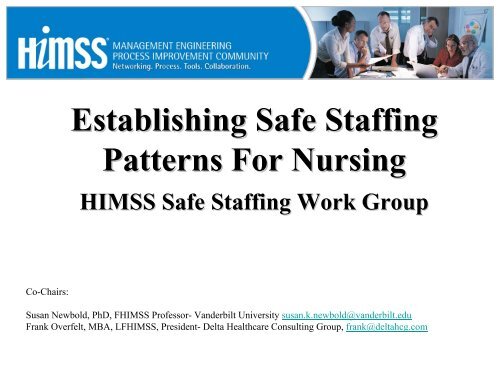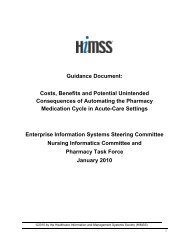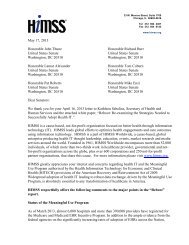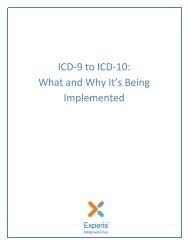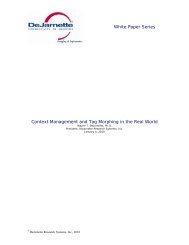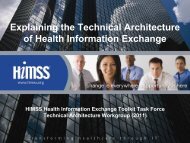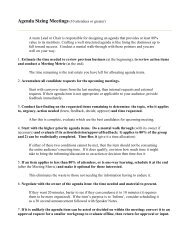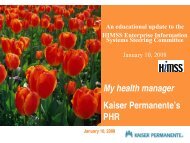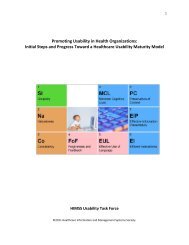Establishing Safe Staffing Patterns for Nurses - himss
Establishing Safe Staffing Patterns for Nurses - himss
Establishing Safe Staffing Patterns for Nurses - himss
You also want an ePaper? Increase the reach of your titles
YUMPU automatically turns print PDFs into web optimized ePapers that Google loves.
<strong>Establishing</strong> <strong>Safe</strong> <strong>Staffing</strong><br />
<strong>Patterns</strong> For Nursing<br />
HIMSS <strong>Safe</strong> <strong>Staffing</strong> Work Group<br />
Co-Chairs:<br />
Susan Newbold, PhD, FHIMSS Professor- Vanderbilt University susan.k.newbold@vanderbilt.edu<br />
Frank Overfelt, MBA, LFHIMSS, President- Delta Healthcare Consulting Group, frank@deltahcg.com
Additional Work Group Members<br />
• J Anderson<br />
• Ali Birjandi<br />
• David Butler<br />
• Christopher Daute<br />
• Sherry Davis<br />
• David Eitel, MD<br />
• Robert Gleason, MN, RN<br />
• John Hansmann, MSIE,<br />
CPHIMSS, FHIMSS<br />
• Helen L. Hill, FHIMSS<br />
• Linda Howell, RN<br />
• Kristie Huff, RN<br />
• Denise Kishel, MBA, MSN, RN<br />
• Pat Lasky, BSN, RN<br />
• Kathleen Malloch, PhD, RN<br />
• Mary Lou Matheke, PhD, RN<br />
• Gia Milo-Slagle<br />
• Andrea Schmid-Mazzoccoli, RN<br />
• Pierce Story<br />
• Mary Lou Weden, RN, MSN<br />
• Kristen Werner<br />
2
Presentation Overview<br />
- Discuss background on <strong>Safe</strong> <strong>Staffing</strong><br />
- Options <strong>for</strong> Nurse <strong>Staffing</strong><br />
- Data-driven Nurse <strong>Staffing</strong> Methodology<br />
- Conclusions<br />
3
Data Driven Approach to Nurse <strong>Staffing</strong><br />
“Hospitals are held together, glued together,<br />
enabled to function…by the nurses”<br />
Thomas, L.1983<br />
“<strong>Nurses</strong> are the early warning system <strong>for</strong><br />
early detection of complications and early<br />
detection of problems in care…”<br />
Aiken L. et al, 2003<br />
4
Cimiotti, Haas, Saiman, Larson, 2006<br />
• Higher RN HPPD resulted in 79% reduction in<br />
risk of blood stream infection between 2 NICUs<br />
• Recommended that staffing decisions based on<br />
census be trans<strong>for</strong>med into acuity driven staffing<br />
decisions<br />
• Findings suggest that RN staffing associated with<br />
risk of bloodstream infection in NICU<br />
Patti Rogers & Frank C. Overfelt 2009<br />
5
<strong>Establishing</strong> <strong>Safe</strong> <strong>Staffing</strong> <strong>Patterns</strong> <strong>for</strong><br />
Nursing<br />
• “Patient <strong>Safe</strong>ty and Quality Patient Care can<br />
be enhanced through the collaborative ef<strong>for</strong>ts<br />
of all HIMSS/SHS communities to provide<br />
useful and effective in<strong>for</strong>mation technology,<br />
enhanced processes, and appropriately<br />
designed staffing ratios <strong>for</strong> Nursing Staff”<br />
HIMSS position paper on <strong>Safe</strong> <strong>Staffing</strong> Ratios- June 2006<br />
6
<strong>Establishing</strong> <strong>Safe</strong> <strong>Staffing</strong> <strong>Patterns</strong> <strong>for</strong><br />
• Background<br />
Nursing<br />
– Mandatory <strong>Staffing</strong> Ratios<br />
• States and Federal Government<br />
• Driven primarily by CNA and other nurses’ unions<br />
• Being touted as “safe staffing ratios”, but based upon no<br />
documentable evidence.<br />
• Same ratios Days and Nights<br />
7
The American <strong>Nurses</strong> Association Nationwide State<br />
Legislative Agenda<br />
NURSE STAFFING PLANS AND RATIOS<br />
Enacted legislation/adopted regulations to date: (13 states plus DC) CA, CT,<br />
DC*, FL, IL, ME*, NJ, NV+, OH, OR, RI, VT, WA, TX[ regulations]<br />
+ represents legislation requiring a study<br />
* legislation was either waived or modified from that which was enacted<br />
Introduced in 2008; (13 states); AZ, CT, FL, HI, IA, MN, MO, NJ, NM, NY, OH, VA, and<br />
As of Feb 2009 WV.<br />
8
<strong>Establishing</strong> <strong>Safe</strong> <strong>Staffing</strong> <strong>Patterns</strong> <strong>for</strong><br />
Nursing<br />
• Only Cali<strong>for</strong>nia and Massachusetts have<br />
actually passed legislation mandating minimal<br />
ratios.<br />
• There has been NO evidence that these ratios<br />
have resolved any patient safety issues nor<br />
improved patient outcomes<br />
9
Alternatives to Mandatory <strong>Staffing</strong><br />
• HIMSS proposes alternatives to mandatory<br />
staffing<br />
*Benchmarking<br />
*Benchmarking supplemented by work sampling<br />
*Work sampling only<br />
*Detailed data collection<br />
10
What Are the Options <strong>for</strong> Nurse<br />
<strong>Staffing</strong>?<br />
Data Driven <strong>Safe</strong> <strong>Staffing</strong><br />
Systems<br />
– Every patient is different by<br />
dependency system<br />
– Accounts <strong>for</strong> recent<br />
procedures<br />
– Workload tied to evidence<br />
in patient’s chart<br />
– Accounts <strong>for</strong> various<br />
aspects of ADL<br />
Fixed Ratios<br />
– Every patient is the same<br />
– Arbitrarily set, even<br />
legislated<br />
– All units with the same<br />
designation are the same<br />
11
What Are the Options <strong>for</strong> Nurse<br />
<strong>Staffing</strong>?<br />
Data Driven <strong>Safe</strong> <strong>Staffing</strong><br />
Systems<br />
– Layout & design issues<br />
considered<br />
– Ancillary Department<br />
support built in<br />
– Family interaction with the<br />
patient is factored in<br />
– Accounts <strong>for</strong> LOS<br />
Fixed Ratios<br />
– All hospitals are the same<br />
– Requires some nurses to<br />
work harder and longer<br />
than some others<br />
– Nurse has an imbalanced<br />
workload even if she has<br />
the same number of<br />
patients<br />
12
Ratios Don’t Equal Hours<br />
13
What Are the Options <strong>for</strong> Nurse<br />
<strong>Staffing</strong>?<br />
Data Driven <strong>Safe</strong> <strong>Staffing</strong><br />
Systems<br />
– Accounts <strong>for</strong> technological<br />
support (EMR, electronic<br />
med cabinets, etc)<br />
– Bed turnover issues<br />
Fixed Ratios<br />
– All shifts are staffed the<br />
same<br />
– Technology is ignored<br />
– Unique patient turnover is<br />
ignored<br />
14
Patient Classification Tool Sets<br />
(One size does not fit all)<br />
• Evidence-based <strong>Staffing</strong> Systems must be<br />
customized <strong>for</strong> all Nursing Specialties:<br />
• Women’s Health<br />
• L&D<br />
• NICU/Nursery<br />
• PICU/Pediatrics<br />
• Oncology<br />
• Palliative Care<br />
• Emergency<br />
Department<br />
15
Engineered <strong>Safe</strong> <strong>Staffing</strong> <strong>for</strong> Nursing<br />
• Evidence-based or engineered <strong>Safe</strong> <strong>Staffing</strong> Systems<br />
<strong>for</strong> Nursing include two major components:<br />
─ Patient Classification (Acuity/Dependency) Systems,<br />
which groups patients into similar groups<br />
─ Development of Engineered <strong>Staffing</strong> Ratios, also called<br />
workload measurement to establish a foundational<br />
database<br />
─ The two must be linked<br />
16
Essential Elements of a Valid Dependency<br />
<strong>Staffing</strong>/Classification System<br />
• Objective – Not subject to individual<br />
interpretation (high inter-rater reliability)<br />
• Auditable – Traced back to patient chart/orders<br />
• Discriminating – Criteria sets must differentiate<br />
between various patients<br />
• Statistically valid- Using generally acceptable<br />
statistical validation methodologies<br />
Patti Rogers & Frank C. Overfelt 2009<br />
17
Workload Measurement<br />
What is it?<br />
• Workload measurement is the process of<br />
determining the hours of care required by each<br />
patient in each “bucket” or dependency level<br />
• Multiple options <strong>for</strong> developing engineered<br />
staffing ratios:<br />
─ Use of hospital’s budgeted HPPD<br />
─ Work sampling<br />
─ Use of database of treatment profiles<br />
─ Detailed engineered staffing ratios/treatment profile development<br />
18
AONE Requirements <strong>for</strong> Setting<br />
Engineered <strong>Staffing</strong> Ratios<br />
• It accounts <strong>for</strong> the:<br />
─Specific layout and design features of a facility<br />
─Technological support (EMR or not; CPOE or<br />
not, etc.)<br />
─Unique dependency/acuity requirements of the<br />
patient<br />
19
AONE Requirements <strong>for</strong> Setting<br />
Engineered <strong>Staffing</strong> Ratios<br />
• It accounts <strong>for</strong> the (cont’d):<br />
─Ancillary department support (pharmacy, imaging,<br />
transport, EVS, etc.)<br />
─Specific mission of the hospital (teaching or not;<br />
specialty of the hospital (pediatric, cardiac, cancer,<br />
etc.))<br />
─Skill mix and education level of the nursing staff<br />
20
Benchmarking Services<br />
• NACHRI (<strong>for</strong> Pediatrics)<br />
• NDNQI<br />
• CALNOC<br />
https://www.calnoc.org/globalPages/mainpage.aspx<br />
• Solucient www.thomsonreuters.com<br />
• GHC Consulting [garrick@garrickhyde.com]<br />
• Delta Healthcare Consulting Group<br />
www.deltahcg.com<br />
21
Workload Measurement<br />
Work Sampling<br />
• 3 rd Party Observer<br />
• Observations every 10-15 minutes<br />
• Focus on Staff, not patient<br />
• Provides work distribution by skill, by shift<br />
• 24 hour sampling time/unit<br />
22
Workload Measurement<br />
Work Sampling<br />
•During Work Sampling Process issues can be identified<br />
•Stage bed huddles in the Emergency Department so the LOS<br />
of ED patients can be observed first hand<br />
•Take action to prevent bolus of admissions occurring at<br />
change of shift (from the ED).<br />
-<strong>Staffing</strong> on inpatient units is already set (2 hours in<br />
advance of shift)<br />
-Transportation of patients to unit at last minute may cause<br />
overtime and delays<br />
-<strong>Nurses</strong> on inpatient units are not available <strong>for</strong><br />
receiving reports on inbound patients.<br />
23
Workload Measurement<br />
Detailed Standards Development<br />
• The hours of care by acuity level are found<br />
by measuring four types of activities:<br />
─Direct care activities (documented)<br />
─Direct care activities (undocumented)<br />
─Indirect care activities<br />
─Routine activities<br />
24
Sample Results of Detailed Engineered<br />
<strong>Staffing</strong> Ratios – Where <strong>Nurses</strong> spend<br />
their time:<br />
Indirect<br />
6%<br />
Direct Care -<br />
Undocument<br />
25%<br />
Direct Care -<br />
Documented<br />
51%<br />
Routine<br />
18%<br />
25
Goals & Objectives of <strong>Safe</strong><br />
Engineered <strong>Staffing</strong><br />
• Optimize staffing at the unit level<br />
• Allocation of appropriate activities to appropriate<br />
skill levels<br />
• Balance Patient Assignments among Caregivers<br />
• Maximize efficiency (minimize non-value added<br />
activities)<br />
26
Patient Classification Services<br />
• McKesson<br />
www.mckesson.com/en_us/McKesson.com/For%2BHealthcare%2BProvid<br />
ers/Hospitals/Nursing%2BSolutions/ANSOS%2BOne-Staff.html<br />
• Delta Healthcare Consulting Group<br />
www.deltahcg.com<br />
• Optilink<br />
www.advisoryboardcompany.com/content/optilink/optilink.html<br />
• ResQ<br />
www.res-q.com<br />
• Clairvia<br />
• API Healthcare<br />
http://www.apihealthcare.com/products/patient_classification/<br />
27
Patient Classification +<br />
Workload Measurement<br />
The Result<br />
Aligns with accrediting & regulatory guidelines <strong>for</strong><br />
staffing:<br />
– ANCC Magnet Accreditation<br />
– AONE<br />
– JCAHO<br />
– State Boards of Nurse Examiners recommendations<br />
<strong>for</strong> staffing<br />
28
Summary<br />
• The patient must remain the focus!<br />
• Improved patient care outcomes is a shared goal<br />
• Optimal nurse staffing can improve patient outcomes<br />
• Call to action: Creation of staffing models qualified<br />
through the metrics of engineered staffing systems to<br />
provide the most effective match between available<br />
resources and desired patient outcomes.<br />
29


